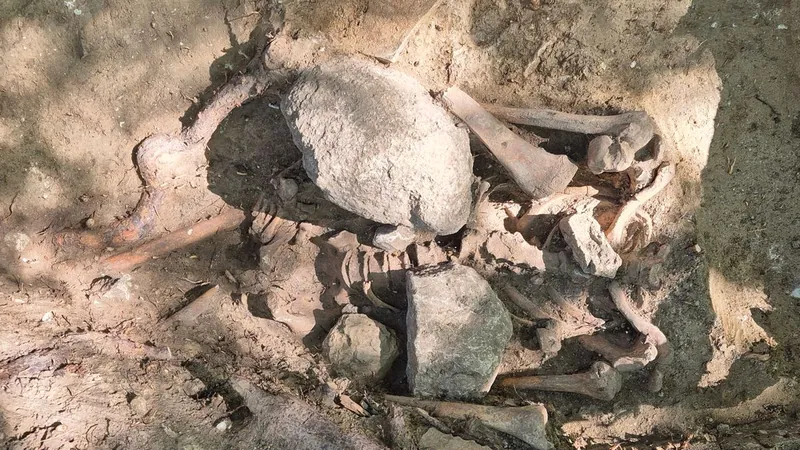
Shocking Discovery: Man Buried with Heavy Stones to Deter Rising From the Dead Found in Germany!
2024-09-19
In a startling archaeological find near the town of Quedlinburg in Saxony-Anhalt, Germany, researchers have unearthed a grave containing the remains of a man who was deliberately weighed down by large stones. This peculiar burial method is believed to have been employed to prevent him from rising from the dead, as locals feared he might return as a so-called "revenant."
The grave, located near a notorious 17th-century gallows site used for executions between the 1660s and early 19th century, adds to the haunting history of this location. Archaeologist Marita Genesis, who is leading the excavation, revealed that this burial site is one of at least 16 discovered in the area, where convicted criminals met their demise.
The fear of revenants, or the undead, surged in Europe from the 16th to the 18th century. Genesis explains, "These individuals may have died prematurely or unexpectedly, without the chance for confession or absolution. Communities took various precautions to ensure the deceased would not return to haunt the living."
In this case, the man was laid to rest face-up and without a coffin, a stark indication of his standing in death. The placement of large stones on his chest was a clear effort to anchor him to the grave, aligning with historical practices aimed at thwarting a possible resurrection.
Further investigation of the skeleton revealed no visible signs of execution, although hangings and drownings often left little evidence. As research continues, archaeologists are hopeful that they can uncover the true cause of death.
Known as "galgenburg," or "gallows hill," the execution site reflects the grim reality of justice in the past where bodies were typically disposed of without ceremony to avoid the need for lengthy burials. Genesis notes the discovery of sharp-force injuries on some skeletons, likely a result of brutal torture methods like "the wheel" or "quartering," which were reserved for society's most heinous offenders.
Interestingly, one burial at the site diverges from the norm: the remains of a person found in a wooden coffin with a respectful arrangement of hands. Archaeologists suspect this individual may have died by suicide, viewed with such societal stigma that they were buried at the gallows as a punishment. The presence of three amber beads suggests a Christian rosary was included, indicating a slightly more compassionate treatment compared to others.
Archaeological experts believe that tens of thousands of similar execution sites once existed across Europe, though many have fallen victim to agricultural expansion and urbanization. The few remaining sites are invaluable in piecing together the legal and cultural history of past societies.
As Genesis aptly puts it, "Examining the layers of an execution site allows us to read the legal history of the era as if it were a book." This revelation not only unearths the dark practices of history but also raises questions about how fear shaped societal norms around death and justice. Stay tuned, as this investigation continues to delve deeper into the macabre tales of the past!



 Brasil (PT)
Brasil (PT)
 Canada (EN)
Canada (EN)
 Chile (ES)
Chile (ES)
 España (ES)
España (ES)
 France (FR)
France (FR)
 Hong Kong (EN)
Hong Kong (EN)
 Italia (IT)
Italia (IT)
 日本 (JA)
日本 (JA)
 Magyarország (HU)
Magyarország (HU)
 Norge (NO)
Norge (NO)
 Polska (PL)
Polska (PL)
 Schweiz (DE)
Schweiz (DE)
 Singapore (EN)
Singapore (EN)
 Sverige (SV)
Sverige (SV)
 Suomi (FI)
Suomi (FI)
 Türkiye (TR)
Türkiye (TR)